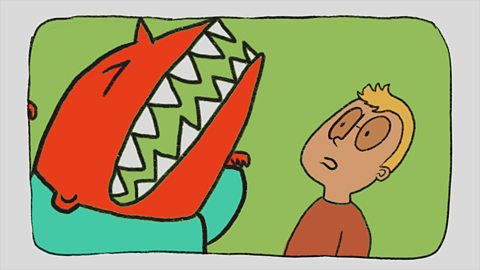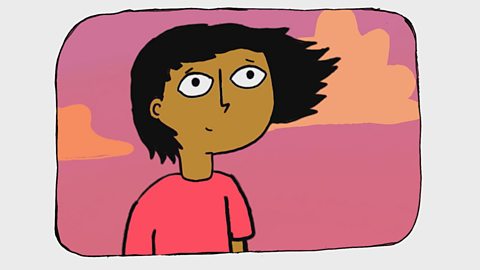TRYSTAN: Yesterday, Mr Phillips came to the house. He's a social worker. He asks questions that Macs and me don't want to answer. I'm Trystan. Macs and me are twins. Everybody asks… why don't we go to school? We don't go, because people are bullying Macs. And now they're bullying me, too, just because I've been standing up for him.
POET: Is it brave thinking you can take on
the whole world just by yourself?
Protective brother, for sure.
But a one-man army
won't be the cure.
To stop the bullying from happening
on the day-to-day,
you have to open up,
tell people that you trust.
Simply put, they can help.
So you don't have to carry this
all by yourself.
TRYSTAN: They say such nasty things about Macs's legs. They chucked all of Macs's books on the floor,and then they report him. And now no-one's talking to us.
POET: You're still the best brother,
that's without a doubt.
People may scream and shout,
because there's an injustice
going on
and they've got to figure out
where it's stemming from.
TRYSTAN: Tea-time today, the phone rings. It was Mr Phillips. He'd found out why we're not going to school, so Dad asked if it was true, but I still couldn't tell him.
POET: The way you love your brother
is a reflection
of how your parents love you.
It's super cute and it's real.
You have to open up for them
to understand how you feel.
See, how we treat others
is a reflection of ourselves.
Bullies bully others,
as they're insecure in themselves.
It doesn't make it OK
in any kind of way,
but someone has to say to them
what they're doing
and how they're treating others
simply isn't OK.
It's just wrong.
We have to make space, so everyone
understands that they belong.
TRYSTAN: I've just heard Mam and Dad talking about tactics. They sounded different - worried, but kind. They were reading something online about bullying.
POET: Treat others
how you wish to be treated
is how the saying goes.
A problem shared is
a problem halved,
and it's better to share the problem
before it escalates too far.
TRYSTAN: What would you do? Would you tell?
Summary of the film
Trystan and Macs are identical twins and Macs is being targeted in school because he uses a walking frame. Trystan stands up for his brother but is then targeted by the bullies too. They decide that the easiest thing to do is to stop going to school, but they don’t tell their parents the reason why.
Teacher notes
Ideas for the classroom:
Make a mask – People often bully others because of personal struggles/challenges, and teachers could discuss this briefly with pupils, eg:
- How does bullying look?
- How do people feel when they’re bullied?
- Why do bullys bully others?
Pupils could be asked to fill in a mask that’s split in half, with drawings and symbols to reflect how the bully looks on the outside and how they feel on the inside.
Groups to discuss ‘Is it ok to bully another person?’. Discussion cards could be distributed with different scenarios on each one to recognise ‘what bullying means’, eg a girl in the classroom keeps pulling someone else’s hair, a pupil on the bus uses mean words towards another person and a boy in school steals someone else’s sandwiches. This could lead to a further discussion about what to do in that situation and how to help someone that’s facing a similar experience.
In groups, pupils could discuss what is acceptable to say and what is best kept as a thought. A game of say v think could include quotes such as:
- Your hair looks awful
- I like your new shirt
- I don’t like your school bag
After this, pupils could categorise them correctly. Teachers should emphasise that there is a difference between being ‘mean’ and ‘bullying’ – a bully targets the person repeatedly. Challenge: Can pupils rewrite the quotes that are best kept as thoughts for them to be said?
- Group poster – Pupils could draw an outline of their hands and include five pieces of advice for someone that is being bullied (one on each finger). They could be displayed around the classroom under the title ‘No bullying’, for example.
Language, literacy and communication ideas:
Diary writing – The narrator uses a series of phrases in the poem, eg “a problem shared is a problem halved”. Pupils could be asked to write a diary from Trystan or Macs’ perspective and create mind maps to think of adjectives and descriptions to include for the characters. This guide on writing a diary could be useful for this task.
A bully’s feelings – Pupils could work in pairs to discuss a bully’s feelings and create a grid of feelings before, during and after bullying someone.
| Before… | During… | After… |
|---|---|---|
This could lead to a task asking pupils to write a monologue from the bully’s perspective.
- Poem writing – There are many key words in relation to bullying in the poem, eg “trust”, “help” and “understand”. Pupils could devise their own poems, such as an acrostic poem, based on these words either from a personal perspective or from the characters’ perspectives.
Learning outcomes and curriculum notes
- Learn about bullying and the emotional and physical impacts
- Raise awareness of the fact that everyone is different
- Learn more about celebrating diversity, the importance of sharing concerns and strategies for dealing with bullying
Area of Learning and Experience – Health and Well-being
How we engage with social influences shapes who we are and affects our health and well-being.
Progression Step 3
I have an understanding of the rules, norms and behaviours of different groups and situations, and I recognise that these have an influence on me.
I can interact pro-socially in different groups and situations.
I have developed an understanding that my values, attitudes and identity are shaped by different groups and influences.
Healthy relationships are fundamental to our well-being.
I can communicate my needs and feelings, and respond to those of others.
I can respect the rights of others and I understand how these impact on myself and others.
Area of Learning and Experience – Expressive Arts
Creating combines skills and knowledge, drawing on the senses, inspiration and imagination.
Progression Step 2
- I can communicate ideas, feelings and memories for an audience and for purposes and outcomes in my creative work.
Where next?
Tyler’s story. video
Tyler gets angry at the smallest thing and loses his temper easily. Will he be able to control his anger and talk about his emotions?

Will’s story. video
Will tries to help his family's financial situation and decides to steal money. Will be regret doing this and try to think of other ways to help?

Amber’s story. video
A school trip makes Amber feel worried for many reasons. Will she be able to survive the weekend and reach the top of the wall?

